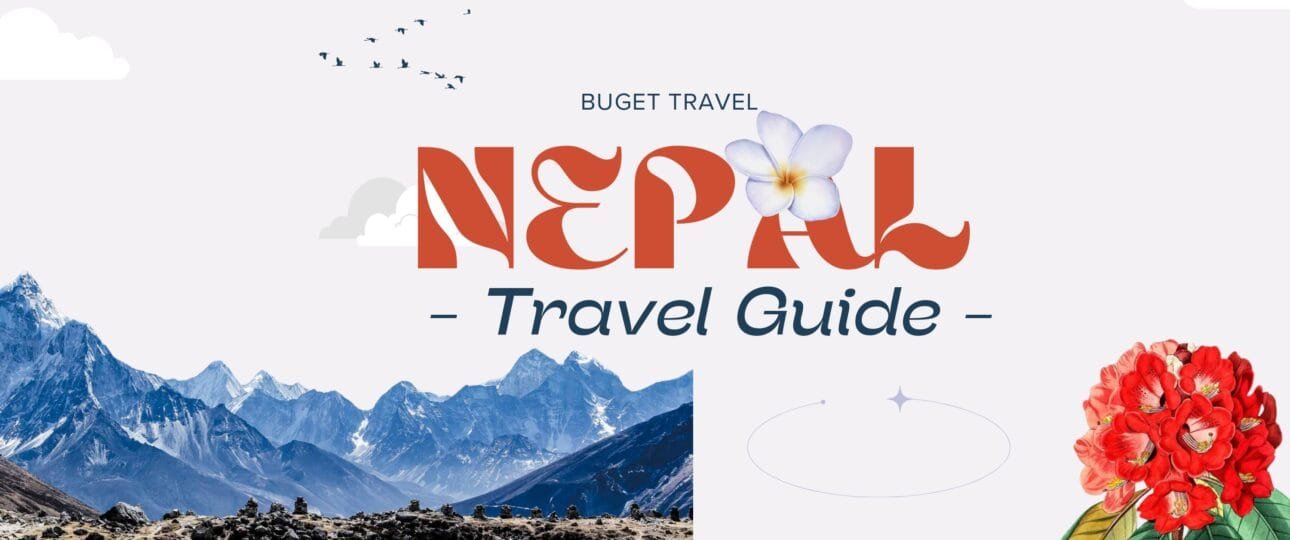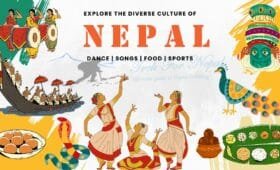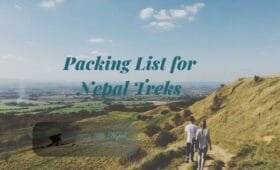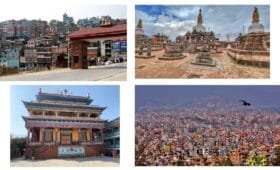Nepal is a dream destination for trekkers, spiritual seekers, and cultural enthusiasts alike. If you’ve been hunting for the perfect Nepal travel guide to plan your next adventure, you’re in the right place. This Nepal tourism guide will take you through Nepal’s most iconic trekking routes, hidden cultural jewels, flavorful cuisine, and practical Nepal travel information you can’t miss. Whether you’re a solo backpacker, a family on holiday, or someone seeking spiritual enlightenment, Nepal welcomes you with open arms and a promise of profound transformation.
This extensive guide discuss everything from Nepal visa requirements to the best time to visit Nepal, explore top Nepal accommodation options, and provide crucial Nepal travel tips for your safety and budget. We’ll also delve into local traditions, highlight important Nepal cultural festivals, and map out some of the country’s awe-inspiring Nepal trekking routes. By the end of this article, you’ll have a clear roadmap to enjoy an unforgettable journey. So, grab a warm cup of Nepali tea and let this Nepal travel guide be your compass to one of the world’s most mesmerizing corners.
Why Visit Nepal?
Nepal, a small Himalayan nation between India and China, boasts remarkable diversity in landscapes, cultures, and experiences. World-class trekking routes and awe-inspiring mountain vistas have put Nepal on the global travel map, yet there’s far more to discover beneath the snowy peaks.
The capital, Kathmandu, exemplifies the country’s dynamic blend of old and new. Medieval courtyards, ancient temples, and bustling bazaars coexist with hip cafes and modern art galleries. Head west, and you’ll encounter Pokhara, a lakeside retreat where adrenaline junkies can paraglide or zip-line against the backdrop of the Annapurna range. Further south, the subtropical lowlands of Chitwan offer wildlife safaris in search of Bengal tigers and one-horned rhinos. Whether you’re fascinated by centuries-old craftsmanship or crave the thrill of uncharted trails, this Nepal tourism guide shows just how much the country has to offer.
According to data from the Nepal Tourism Board, the country welcomed over 1 million international travelers in 2019 alone. This statistic highlights Nepal’s growing popularity, especially for adventure tourism. Throw in a deep-rooted cultural and spiritual heritage—from Hindu temples to Buddhist monasteries—and you’ll quickly understand why Nepal enthralls globetrotters from every corner of the world.
Best Time to Visit Nepal
The best time to visit Nepal often depends on what you want from your trip. Nepal has four primary seasons: spring (March-May), summer/monsoon (June- August), autumn (September- November), and winter (December- February). Each season carries unique pros and cons:
- Spring (March- May): With warmer weather and abundant rhododendron blooms in mountainous areas, this season is ideal for moderate hikes.
- Summer/Monsoon (June-August): Lush green landscapes and fewer tourists, but heavy rainfall may disrupt trekking plans.
- Autumn (September-November): Clear skies, comfortable temperatures, and vibrant festivals. It is widely considered the best time for trekking and sightseeing.
- Winter (December-February): Crisp air, fewer crowds, and off-season rates. However, high-altitude treks become more challenging due to snowfall.
Many travelers prefer autumn for its pleasant weather and spectacular mountain views. However, to witness Nepal’s cultural pulse, plan around major Nepal cultural festivals like Dashain (September/October) and Tihar (October/November). Regardless of your choice, keep an eye on your chosen activities to align your schedule with optimal weather conditions.
Nepal Visa Requirements and Travel Documents
Understanding Nepal visa requirements is crucial for smooth entry. Most nationalities can obtain a Nepal visa on arrival at Tribhuvan International Airport in Kathmandu or at land border checkpoints. Visa fees vary by duration, typically 15, 30, or 90 days. You can also apply for an e-Visa online to expedite your arrival process.
Ensure your passport remains valid for at least six months beyond travel dates. Pack a few passport-size photos for visa forms, trekking permits, or local SIM card registrations. If you plan extensive travels, carrying multiple passport photos proves handy.
You may require additional permits or different visa categories for specialized activities, such as high-altitude mountaineering or volunteering. Check official resources or consult your tour operator for the most accurate and up-to-date Nepal travel information. Immigration rules can change, so it’s wise to verify details with the nearest Nepalese embassy before finalizing your itinerary.
Cultural Etiquette and Traditions
Nepalese culture blends Hindu, Buddhist, and indigenous traditions, which are celebrated in festivals, architecture, and everyday life. Respect plays a pivotal role in local customs:
- Greetings: Locals greet with a “Namaste” or “Namaskar,” palms pressed together in a prayer-like gesture that reflects respect and sincerity.
- Temple Etiquette: Remove your shoes before entering temples or monasteries. Ask for permission before taking photos in sacred sites.
- Dress Code: Nepalis generally dress modestly. While casual attire is acceptable in tourist areas, covering your shoulders and knees is advisable when visiting religious landmarks.
- Right-Hand Rule: In many parts of Nepal, using your right hand to give or receive items is polite. The left hand is traditionally deemed unclean.
- Avoid Pointing Feet: Pointing your feet at people or religious objects can be disrespectful, as feet are regarded as the lowest part of the body.
Learning these basic etiquettes can foster positive interactions and help you immerse yourself fully in local life. Embrace the cultural richness with openness and curiosity, and you’ll often be rewarded with warm hospitality and heartfelt connections.
Highlights of Nepal Cultural Festivals
Festivals in Nepal are kaleidoscopes of color, music, and communal joy. The country celebrates over 50 festivals annually, each steeped in legend and religious significance. Key celebrations include:
- Dashain: Nepal’s most significant Hindu festival, lasting 15 days. Families reunite, offer prayers to the Mother Goddess Durga, and receive blessings from elders.
- Tihar: Also known as the Festival of Lights, Tihar honors crows, dogs, cows, and siblings across five days. Vibrant oil lamps and flower garlands adorn homes, creating a magical atmosphere.
- Holi: The festival of colors sees people joyfully throwing colored powders and water at each other. Streets become a riot of hues and laughter.
- Buddha Jayanti: Celebrated in Lumbini and Buddhist enclaves, this festival commemorates the birth of Gautama Buddha with chanting, processions, and candlelit vigils.
Planning your trip around one of these Nepal cultural festivals could enhance your experience. You’ll see locals dressed in their finest attire, singing folk songs, and inviting visitors to enjoy the fun. The vibrancy of these gatherings can be a highlight of any Nepal travel itinerary.
Essential Nepal Travel Tips
Before embarking on your journey, consider these vital Nepal travel tips to ensure a seamless adventure:
- Currency and Payments: The Nepali Rupee (NPR) is the local currency. ATM access is relatively widespread in cities like Kathmandu and Pokhara, though you may find fewer machines in rural areas. Carry some cash for remote trekking zones.
- Connectivity: SIM cards with data packages are affordable and widely available. Major providers include Ncell and Nepal Telecom. The internet can be spotty in mountainous regions, so plan backups if you need consistent connectivity.
- Local Simplicity: Street vendors offer everything from fresh produce to handmade trinkets. Haggling is acceptable, but do so politely. Buying from small businesses supports local families.
- Responsible Tourism: Nepal’s pristine environment requires thoughtful travelers. Avoid single-use plastics. Follow the “leave no trace” principle on trekking routes, and respect wildlife by keeping your distance.
- Emergency Numbers: Dial 100 for police and 101 for fire services. Keep your embassy details handy in case of emergencies.
Adhering to these guidelines will enrich your experience and positively impact the communities and environments you explore.
Crafting the Perfect Nepal Travel Itinerary
Creating a Nepal travel itinerary may seem daunting, given the country’s endless possibilities. Focus on your priorities—culture, nature, adventure, or a mixture. Here’s a sample itinerary breakdown:
- Day 1-3: Arrive in Kathmandu, explore key temples like Swayambhunath and Pashupatinath, and stroll through the medieval courtyards of Durbar Square.
- Day 4-6: Bus or fly to Pokhara. Enjoy lakeside leisure and paraglide for panoramic views, and visit the World Peace Pagoda.
- Day 7-10: Embark on a short trek like Poon Hill or Mardi Himal if you want to sample the majesty of the Annapurnas.
- Day 11-13: Head to Chitwan National Park for a safari, community-based Tharu cultural programs, and forest walks.
- Day 14: Return to Kathmandu, shop for souvenirs in Thamel, or enjoy a Himalayan sunrise from Nagarkot before departure.
This structure allows you to taste Nepal’s variety—urban exploration, Himalayan treks, and lowland jungles. Adjust it to accommodate extended treks or deeper cultural dives, making your itinerary as unique as your wanderlust.
Must-See Destinations in Nepal
Nepal’s top destinations span from vibrant cities to remote mountain passes. Here are some can’t-miss spots:
- Kathmandu Valley: Beyond the capital city, the valley includes Patan and Bhaktapur, each boasting historical Durbar Squares and breathtaking architecture.
- Pokhara: An adventurer’s paradise, offering everything from caving and waterfall excursions to paragliding and trekking.
- Lumbini: Renowned as the birthplace of Buddha and a UNESCO World Heritage site, drawing spiritual pilgrims from around the globe.
- Chitwan National Park: A haven for wildlife enthusiasts eager to spot rhinoceroses, Bengal tigers, and diverse birdlife in lush jungles.
- Everest Region: Home to Sagarmatha National Park and the world’s highest peak. Perfect for serious mountaineers and trekkers chasing once-in-a-lifetime experiences.
Each of these locales can anchor a segment of your overall journey. Whether you focus on culture, wildlife, or high-altitude treks, these pillars of Nepal’s geography and heritage will enrich your travels.
Nepal Trekking Routes: A Step-by-Step Overview
Trekking is at the heart of most Nepal travel blogs, and with good reason. The nation boasts an array of trails, from beginner-friendly to highly challenging. Commonly cited routes include:
- Annapurna Circuit: Famous for its diversity in landscapes and cultures, circling the Annapurna Massif with a peak point at Thorong La Pass (5,416m).
- Everest Base Camp Trek: Offering iconic views of Everest and a deep dive into Sherpa culture. The route meanders through Tengboche Monastery and high-altitude hamlets.
- Langtang Valley Trek: Accessible from Kathmandu, featuring bamboo forests, waterfalls, and expansive alpine meadows with fewer crowds.
- Manaslu Circuit: A rugged alternative for trekkers seeking lesser-known terrain. Requires special permits, adding an air of exclusivity.
Before hitting the trail, check for TIMS (Trekkers’ Information Management System) cards and relevant permits for conservation areas. Training, altitude preparedness, and a reliable guide can make or break your trekking experience. High-altitude hikes require caution due to potential risks of Acute Mountain Sickness (AMS). Always pace yourself, stay hydrated, and heed local advice to ensure a safe expedition.
Nepal Accommodation Options
Whether you’re a budget traveler or a luxury seeker, Nepal accommodation options cater to every preference. You’ll find everything from backpacker hostels in Thamel to five-star boutique hotels overlooking the Annapurna range. In trekking regions, “teahouses” offer simple lodging with communal dining halls—a perfect place to share adventure stories with fellow hikers.
- Hotels and Resorts are standard in Kathmandu, Pokhara, and Chitwan, and they feature modern amenities like Wi-Fi and hot showers.
- Teahouses: Located along major trekking routes, providing basic rooms, local meals, and an authentic mountain ambiance.
- Homestays: Opportunities to stay with Nepali families, especially in rural areas. You’ll experience local customs firsthand while contributing to community-based tourism.
- Guesthouses: Mid-range accommodations that blend affordability with comfort, often featuring private rooms, laundry services, and an on-site restaurant.
Prices vary by season and location. Treks during high season may lead to fully booked teahouses, so plan accordingly. If you prioritize cultural immersion and direct community support, consider booking homestays or smaller family-run guesthouses.
Exploring Nepalese Cuisine and Dining Etiquette
Nepalese cuisine mirrors the nation’s cultural mosaic, featuring robust flavors that vary by region. Staples like dal Bhat (lentil soup with rice) and momo (dumplings) are universally cherished. You might savor hearty portions of thukpa (noodle soup) in mountainous areas, while the Terai region loves spicier dishes influenced by Indian and indigenous flavors.
Dining etiquette typically involves sharing plates and eating with your right hand if you’re among locals. Meals often revolve around local produce, so expect fresh vegetables and locally sourced meats. Hygiene standards can vary, especially in street food stalls, so gauge cleanliness before partaking. Many cafes and restaurants in tourist areas are well-versed in vegetarian and vegan diets, reflecting the global traveler’s presence.
Transportation and Getting Around
Navigating Nepal can be an adventure in itself. Primary modes of travel include:
- Domestic flights are ideal for quickly covering long distances. Popular routes connect Kathmandu to Pokhara, Lukla, and Bharatpur (near Chitwan). Delays are common, especially in the monsoon or winter, so maintain flexibility.
- Buses: Budget-friendly but can be time-consuming and bumpy. Luxury tourist buses run between Kathmandu and Pokhara, offering a more comfortable ride than local alternatives.
- Private Cars and Jeeps: These are more expensive, but they grant convenience and the ability to make spontaneous stops. They are great for groups or families.
- Taxis and Rickshaws: Readily available in cities. Agree on fares upfront or ensure the meter is used.
For city travel, apps like Pathao and Tootle function similarly to ride-shares, primarily for motorcycles. Keep small changes handy for shorter journeys. Donkey caravans and porters transport goods in mountainous regions, reflecting Nepal’s unique geography.
Health, Safety, and Nepal Travel Advice
Your health and safety come first. To that end, consider these key points:
- Altitude and Fitness: High-altitude treks demand physical preparation and gradual acclimatization. Symptoms like headaches or dizziness might indicate AMS; don’t ignore them.
- Vaccinations: Consult a healthcare provider about recommended shots, such as hepatitis A, typhoid, and tetanus.
- Travel Insurance: A robust policy covering medical evacuations can be a lifesaver if an emergency strikes in remote regions.
- General Hygiene: Stick to purified water and adequately cooked meals. Hand sanitizer is essential.
- Scams and Theft: While violent crime is rare, petty theft can happen in crowded tourist areas. Store valuables securely and remain vigilant, especially in busier neighborhoods.
Follow these guidelines, and you’ll reduce the risk of untimely mishaps, letting you enjoy your Nepali adventure with greater peace of mind.
Nepal Travel Packages: Tailoring Your Experience
Travel agencies offer a range of Nepal travel packages catering to diverse interests. You might opt for an all-inclusive trekking package to the Annapurna Base Camp or a cultural tour that weaves through Kathmandu, Pokhara, and Lumbini. Tailor your package to include:
- Accommodation: Select from luxury resorts to modest teahouses.
- Transportation: Domestic flights, private drivers, or group buses.
- Guided Tours: Expert local guides enrich experiences with storytelling and insider tips.
- Adventure Activities: Paragliding, rafting, canyoning, or wildlife safaris.
- Optional Add-ons: Yoga retreats, cooking classes, or volunteering opportunities.
Whether you choose a pre-set package or customize your itinerary, consider personal preferences and budget. Reputable agencies will help you navigate the logistical complexities, especially if you’re short on planning time or traveling with a group.
Frequently Asked Questions (FAQs)
- Do I need a visa to enter Nepal?
Yes, most travelers require a visa. You can get one on arrival or apply online. Ensure your passport is valid for at least six months. - What is the best time to visit Nepal?
Autumn (September-November) is popular for clear skies and moderate temperatures. Spring (March-May) is another excellent window, especially for blooming rhododendrons. - Is Nepal safe for solo travelers?
Nepal is generally considered safe. Nonetheless, take common-sense precautions, such as safeguarding valuables and sticking to established trekking routes. - How physically challenging are Nepal trekking routes?
It varies. Beginner-friendly treks like Poon Hill are moderate, while Everest Base Camp or Annapurna Circuit demands more excellent fitness and altitude acclimatization. - What about Nepal accommodation options in remote areas?
Teahouses and homestays are available along most trekking paths. They offer basic amenities, communal dining, and a chance to mingle with locals and fellow trekkers. - Can I visit Nepal on a tight budget?
Absolutely. Budget-friendly lodgings, street meals, and local buses keep costs low. Negotiate market prices and use travel hacks like sharing taxis for an even cheaper experience. - Do I need travel insurance for Nepal?
While not mandatory, travel insurance is highly recommended, especially for trekking. Policies covering helicopter evacuations can be a lifesaver in high-altitude emergencies.
Success Stories and Testimonials
Travelers often describe Nepal as life-changing. Jessica, an avid trekker from Australia, recounts how her hike to Annapurna Base Camp sparked a newfound reverence for nature. She raves, “Every sunrise felt like a spiritual awakening.” Another traveler, Tomas from Spain, immersed himself in a homestay experience near Bhaktapur, where he learned to cook dal bhat and bonded with a local family. He said, “Nepal’s hospitality made me feel at home halfway around the world.”
Such stories reflect the transformative potential of the Nepali experience. From learning about Buddhist philosophies in Lumbini to building lifelong friendships with trekking guides, the country fosters connections that endure beyond departure flights.
Why You Should Volunteer with ViN
If you aim to forge deeper relationships while making a positive impact, consider volunteering. Volunteers Initiative Nepal (ViN) connects enthusiastic travelers with community projects across education, healthcare, and environmental conservation. Opportunities range from teaching English in rural schools to participating in reforestation efforts in the hilly regions.
Volunteering brings tangible benefits to local communities while gaining profound insights into Nepali culture. It’s also a chance to hone skills, build meaningful friendships, and break cultural barriers. Many past volunteers describe their time with ViN as the highlight of their travels—a powerful blend of altruism and self-discovery. Whether you have a week or several months, your involvement can uplift lives and leave an enduring mark.
Conclusion: Embark on Your Nepalese Adventure
From the spiritual hum of Kathmandu’s ancient courtyards to the adrenaline rush of high-altitude treks, Nepal offers an array of experiences that few destinations can rival. This Nepal travel guide has provided crucial insights, from visa requirements to recommended Nepal travel tips. By blending cultural immersion with natural wonders, your journey will be as enlightening as it is exhilarating.
Now that you have the essential Nepal travel information, we invite you to take the next step. Book that flight, plan your itinerary, and brace yourself for memories that will last a lifetime. And if you’re looking for a way to give back, Volunteers Initiative Nepal (ViN) welcomes helping hands through volunteering, internships, or donations. Your support can transform local communities and preserve Nepal’s heritage for future generations. Share this Nepal travel blog with friends and family who might be inspired to join your Himalayan escapade. The mountains are calling—will you answer?
Ready to explore breathtaking landscapes? Book your tour now and get ready for an unforgettable experience!




